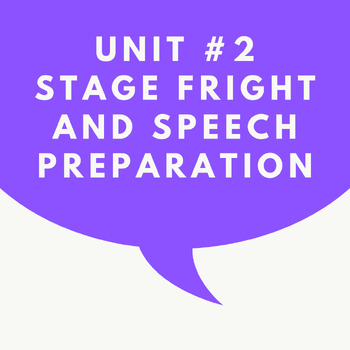Unit #2: Stage Fright and Speech Preparation - Oral Communication or Speech
Ms Flanagan Says
5 Followers
Grade Levels
9th - 12th
Subjects
Resource Type
Standards
CCSSW.9-10.1c
CCSSW.9-10.1d
CCSSW.9-10.1e
CCSSW.9-10.2
CCSSW.9-10.2a
Formats Included
- Google Drive™ folder
Ms Flanagan Says
5 Followers

Made for Google Drive™
This resource can be used by students on Google Drive or Google Classroom. To access this resource, you’ll need to allow TPT to add it to your Google Drive. See our FAQ and Privacy Policy for more information.
What educators are saying
These supplementals were a perfect addition to my Fear of Public Speaking Unit. My kids loved the Pet Peeve speech.
Also included in
- This bundle is an entire, semester-long course of an oral communication or speech class. The 5 units of varying lengths each end in a student-generated and delivered speech, culminating in a group speech for charity at the end. Unit #1: Communication ProcessUnit #2: Stage Fright and Speech PreparatiPrice $35.10Original Price $39.00Save $3.90
Description
This folder contains all you need to teach a unit on stage fright and the different kinds of speech
- Unit #2 - Stage Fright and Speech Preparation Lecture Slides (Lesson #1 is preview)
- Guided Notes for Lecture Slides
- TED Ed Discussion: "The Science of Stage Fright"
- Unit #2 Review Game: “Um Actually…”
- Unit #2 Test - PDF of Google Form
- Epideictic Speech - 2 Options: My Hero or Pet Peeves
- Rubric for Epideictic Speech - Standards-Based
Total Pages
Answer Key
N/A
Teaching Duration
2 Weeks
Report this resource to TPT
Reported resources will be reviewed by our team. Report this resource to let us know if this resource violates TPT’s content guidelines.
Standards
to see state-specific standards (only available in the US).
CCSSW.9-10.1c
Use words, phrases, and clauses to link the major sections of the text, create cohesion, and clarify the relationships between claim(s) and reasons, between reasons and evidence, and between claim(s) and counterclaims.
CCSSW.9-10.1d
Establish and maintain a formal style and objective tone while attending to the norms and conventions of the discipline in which they are writing.
CCSSW.9-10.1e
Provide a concluding statement or section that follows from and supports the argument presented.
CCSSW.9-10.2
Write informative/explanatory texts to examine and convey complex ideas, concepts, and information clearly and accurately through the effective selection, organization, and analysis of content.
CCSSW.9-10.2a
Introduce a topic; organize complex ideas, concepts, and information to make important connections and distinctions; include formatting (e.g., headings), graphics (e.g., figures, tables), and multimedia when useful to aiding comprehension.



